Continuing with our block-by-block tour of our “Fate by Evil Hat” character sheet for Roll20: the many ways of taking harm!
Setting the default Conditions, Consequences, and Stress Tracks
When setting the default values for the game (see Part 1 of this series), you may have chosen a pre-built sheet (e.g., Fate Core, Fate of Cthulhu, etc.) which sets the stress tracks, conditions, and/or consequences for the game. But you may also want to select your own:
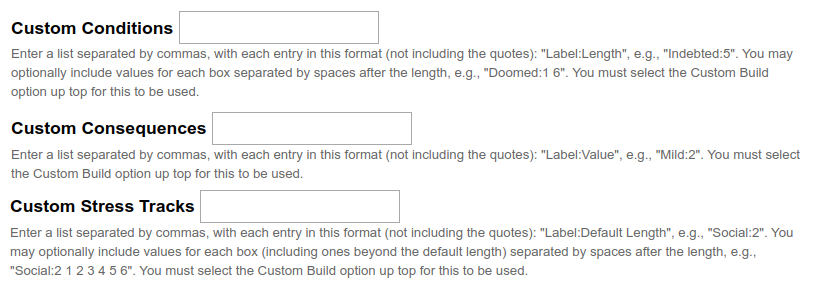
Consequences
Let’s start with consequences because they are the simplest to build: enter each consequence with its label and the number of points of harm it absorbs, separated by a colon, and each consequence entry separated by a comma, in the “Label:Value” format. For example, the default consequences in Fate Core, Fate Accelerated, and Fate Condensed are entered as:
Mild:2, Moderate:4, Severe:6
Stress Tracks
Stress is set in a similar way, but you also have the option of indicating the default value of each box. The syntax is: “Label:Default Length” followed by the optional values for each box (including ones beyond the default length) separated by spaces after the length; again, entries are separated by commas. So the Fate Accelerated stress track is:
Stress:3 1 2 3 4 5
The Fate Core tracks would be entered as:
Physical:2 1 2 3 4 5 6, Mental:2 1 2 3 4 5 6
And the Fate Condensed tracks, which uses only one-point stress boxes, would be written as:
Physical:3 1 1 1 1 1 1, Mental:3 1 1 1 1 1 1
Or if you want, simply Physical:3, Mental:3 which will produce blank boxes.
Conditions
Conditions are spelled out as a sort of hybrid between consequences and stress tracks; they are specified as “Label:Length”, followed by the optional value (all boxes in the condition trac are the same value). So the default values in the Fate World Weird World News can be entered as:
Growling Stomach (fleeting):1, Shivering (fleeting):1, Hungry (sticky):2, Panicked (sticky):2
More Stress
Now let’s launch the game and look at the character sheet proper.

In addition to whatever defaults you selected, you can add more tracks, either from the Quick Add drop-down at the top, which lets you add pre-formatted tracks, or from the bottom button, which adds a blank track.
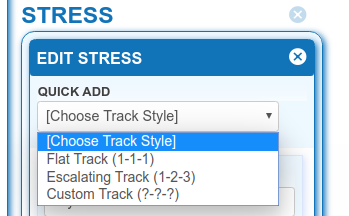


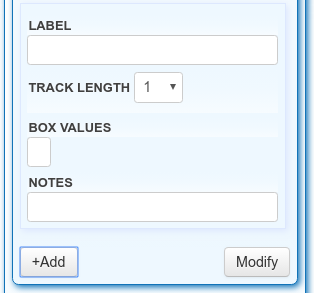
As in the other blocks, you can reorder or delete items using the “Modify” button.
Further Consequences
If you are using consequences, that block will usually be located immediately under the Stress section. In addition to showing your pre-loaded default consequences, the character sheet once again allows you to add pre-built consequences (from the Quick Add drop-down at the top) or build new ones (from the +Add button at the bottom), and to re-order or delete items from the list using the “Modify” button.

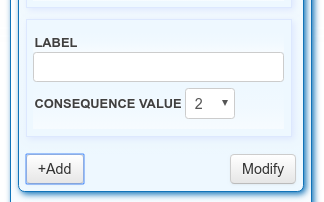
And Some Conditions
Your game will usually have either consequences or conditions. I tend to be a little more fussy about how I set up conditions. The character sheet allows for easy loading of the label, value, and length of each condition track but we also need to know whether the condition is fleeting, sticky, or lasting. It can be included in brackets within the label, like I did in the example above in the custom condition labels for the global sheet setup. These would display as:
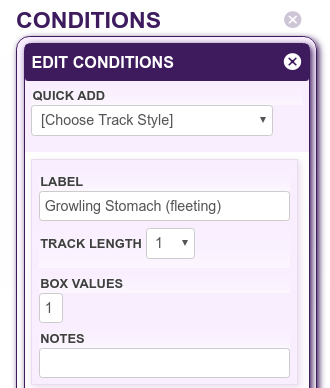
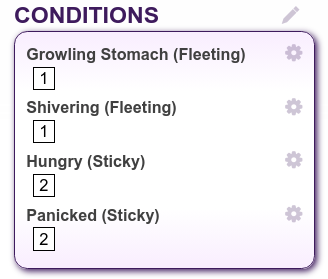
But as a personal preference, I like to have the condition type displayed in the notes instead so I move them manually:
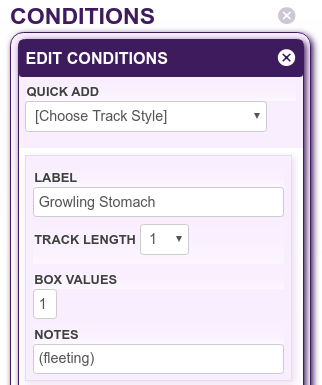
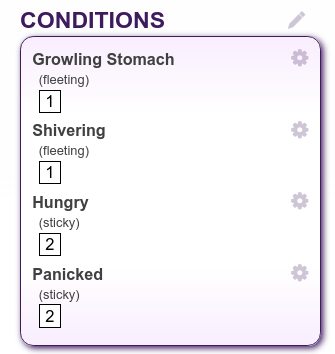
Conditions are a very flexible tool and in some implementations of Fate, can become quite elaborate. In Dresden Files Accelerated, for example, they are a key mechanical element not only for handling damage but all sorts of narrative elements as well:


In the next post, we will look at powers, corruption, and other extras.
